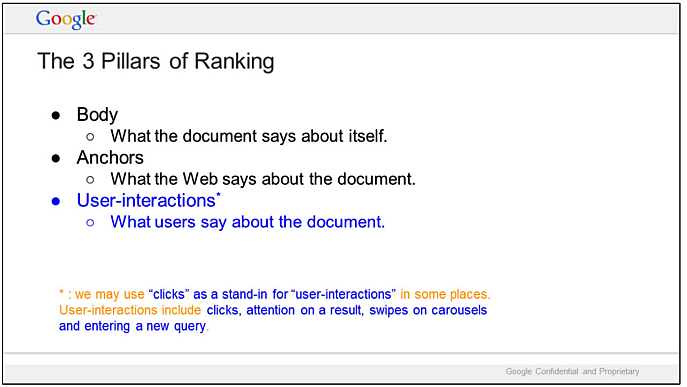Table Of Content
Have you heard the buzz in the SEO community about some recently released U.S. Department of Justice (DOJ) documents?
These documents offer a glimpse into how Google’s ranking system works.
It’s causing quite a stir, and we’re here to break it down for you simply.
In these documents, there’s a slide titled “The 3 Pillars of Ranking.”
This slide sheds light on three fundamental aspects that are crucial in determining how Google ranks web pages.
Let’s dive into each of these pillars one by one.
1. Body: What The Document Says About Itself
The first pillar, “Body,” focuses on what the document itself contains. In simpler terms, it’s all about the content.
The quality, relevance, and uniqueness of the content on a web page play a vital role in how Google assesses its ranking. Is the content informative, well-written, and valuable to users?
Google uses these factors to determine how high a page should appear in its search results.
2. Anchors: What The Web Says About The Document
The second pillar, “Anchors,” refers to what the wider web says about the document. In other words, it’s about backlinks.
When other reputable websites link to a particular page, it’s like a vote of confidence.
Google sees these links as endorsements, indicating that the content is trustworthy and authoritative.
Therefore, the number and quality of backlinks pointing to a webpage can significantly influence its ranking.
3. User-Interactions: What Users Say About The Document
The third and final pillar is “User-Interactions,” which involves how users interact with a webpage. This includes factors like clicks, attention on a result, swipes on carousels, and even when users enter a new search query. Essentially, it’s all about user engagement.
If users are clicking on a search result, staying on the page, and finding what they need, Google takes this as a sign that the page is relevant and valuable.
Now, here’s where it gets even more interesting. The DOJ documents reveal that “clicks” are sometimes used as a stand-in for “user-interactions” in certain contexts.

This means that when you click on a search result, it’s not just a simple action; it’s a key factor in how Google evaluates the quality and relevance of the page.
Cyrus Shepard was among the first to spot these revelations in the DOJ documents, and he shared his findings in a Twitter thread.
His tweets shed light on the significance of these three pillars and how they impact your website’s performance on Google’s search results.
Understanding these pillars can be a game-changer for anyone looking to improve their website’s visibility on Google.
That’s it! For similar industry news, keep visiting this space.









